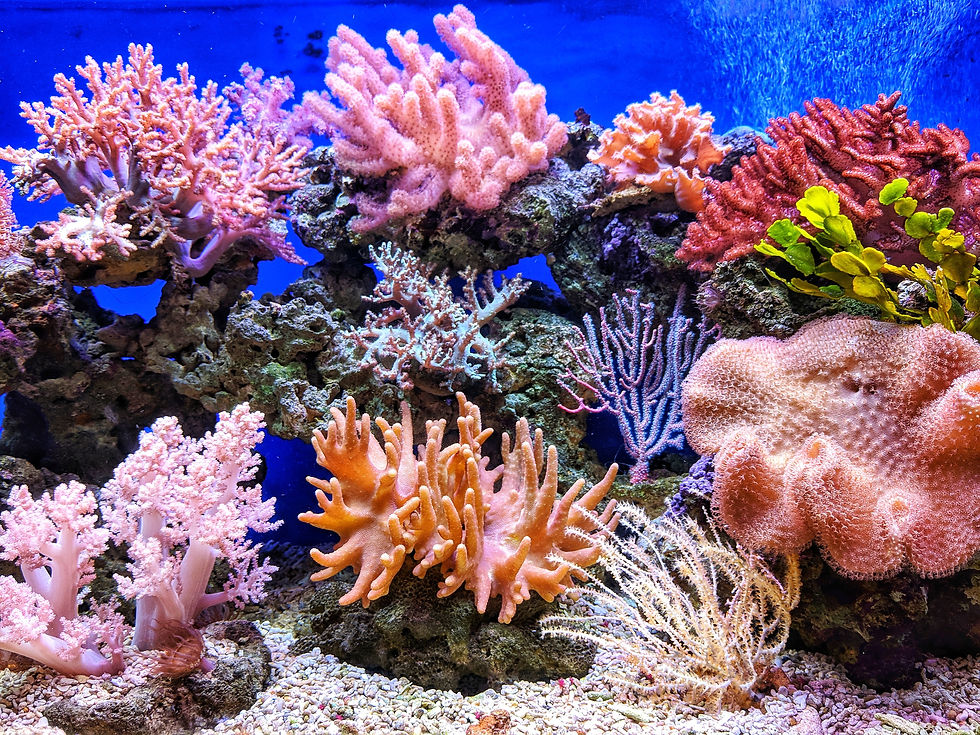World Oceans Day Tainted By Fashion?
- Natasha Judge

- Jun 1, 2021
- 4 min read
Updated: Aug 13, 2021
World Oceans Day takes place annually on June 8th. The day aims to unite people worldwide to assist maintaining the longevity of our oceans.
The purpose of World Oceans Day is to inform people of our impact as humans towards the ocean.
Moreover, the fashion industry is detrimental in harming the biosphere. Microfibres are just one of the dangerous factors facing sea habitats. More than 8 million metric tonnes of plastic enters the oceans each year. Consequently, it is evident that the fashion industry needs to do more.
World Oceans Day 2021
The event celebrates the important role of oceans within our everyday life. It focuses on the natural beauty of the seas, whilst simultaneously raising awareness of the crucial factors in using oceans as a resource.
Each year the United Nations decide a theme for the day. Within 2020, we saw an innovation theme which introduced different ways to incorporate ocean sustainability within our daily lives. This year the theme is “The Ocean: Life and Livelihoods” with an aim to gather support for ocean populations.
The UN are devising an event with presentations and panel discussions, to deliver the latest information and show discoveries made of the oceans ecosystems.
Fashion manufacturing microfibres
The visible litter we see on beaches are only as small as 1% of the problem facing our oceans. The majority is made up of microfibres.
Firstly, the process of turning fossil fuels into textiles releases greenhouse gasses and throughout the lifetime of clothes microfibres detach.
Microfibres are tiny threads shed off clothes during the manufacturing process, and when washing. They can come from all synthetic materials containing plastic, including polyester, acrylic and nylon. Microplastics are released within each wash cycle and are a posing threat as they accumulate in marine habitats worldwide.
Research shows that a single machine load of clothes can shed over 700,000 fibres. Despite some being caught within washing machine filters, it is estimated that 1.4 quadrillion are within the seas. This creates a threat to marine life as microfibres absorb poisonous substances, creating a toxic habitat for sea life.
This is not just impactful of the ocean habitats as the fibres are entering the food chain, meaning human health can also be at risk. The North Sea contains microfibres which marine life consumes, and as a result 63% of shrimp contain microfibres. Additionally, within an Atlantic Ocean study, they found microfibres within the guts of sharks off the UK coast.
Over a third (35%) of microplastics released into oceans are from synthetic textiles. Fashion companies have been criticised for being too slow to address this prominent issue affecting our oceans.
What can the fashion industry do?
Only 20% of fashion brands have a strategy in place to prevent microfibres in their clothing (Fashion Transparency index, 2020). This figure must increase for active change to be made to aid oceans and their habitats.
The Fashion Pact is an organisation made up of chief executives from the fashion industry. They have over 60 members including H&M, Nike, Burberry, and Prada. One commitment of this organisation is to protect the oceans and eliminate microfibre production from the washing of materials.
Ultimately, for this goal to be achieved more companies need to take part and change their methods and production process. A collective power would eradicate the microfibre problems.
Some brands are incorporating recycled materials taken from the oceans into their production. An example of this is adidas, as currently the brand has a “Prime Blue” collection, which reuses Parley Ocean plastics to make fashionable products. Also, adidas are shifting to only using recycled polyester in their products by 2024, which will greatly aid the removal of plastic waste within our oceans.
Activewear brand Woven are another great example of a sustainable business model. They use fabric made from broken down discarded plastics and create repurposed clothing from recycled plastic.
Unfortunately, many fashion outlets have still not incorporated sustainable practices within the manufacturing and distribution processes. The business models of fashion companies need to change, as this is where the microfibre problem is continually located.
How we can support World Oceans Day
The United Nations found that 50% of coral reefs have been destroyed and a significant 90% of large fish are endangered. Society is taking more than can be replenished, so we need to change and create more innovative ways to protect oceans.
Individually, we can be mindful of the brands we are buying from and support businesses which use recycled materials from the oceans within their products. Ideally, you should purchase clothes made from natural fibres, including wool, linen, and cotton because any microfibres shed will eventually break down in the environment.
Furthermore, we can use cooler temperatures when washing our garments as this means textiles will be less likely to break down. Aim to fill a washing machine so that there is less friction between the clothes, resulting in less microfibres. Also, there are fibre collecting devices for washing machines, which will eliminate the fibres entering our oceans.
As World Oceans Day approaches it is hoped that collective work from us and the fashion industry will aid the sustainability movement for our oceans.
For further information on World Oceans Day 2021 visit here and for more on Fashion and Our Oceans visit Mindless Mag.



Comments